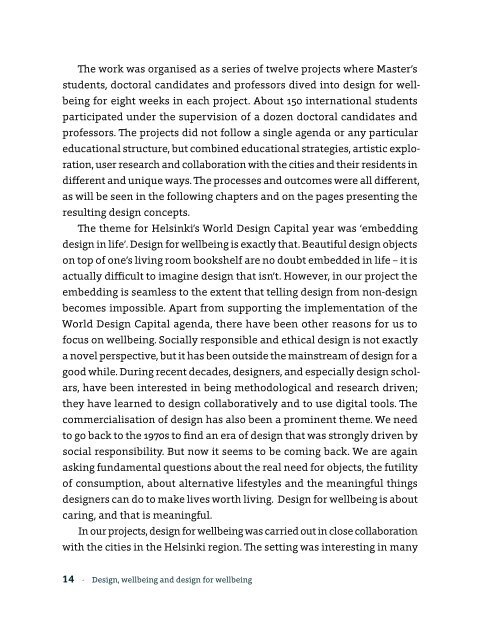Designing for wellbeing
Designing for wellbeing
Designing for wellbeing
Create successful ePaper yourself
Turn your PDF publications into a flip-book with our unique Google optimized e-Paper software.
The work was organised as a series of twelve projects where Master’s<br />
students, doctoral candidates and professors dived into design <strong>for</strong> <strong>wellbeing</strong><br />
<strong>for</strong> eight weeks in each project. About 150 international students<br />
participated under the supervision of a dozen doctoral candidates and<br />
professors. The projects did not follow a single agenda or any particular<br />
educational structure, but combined educational strategies, artistic exploration,<br />
user research and collaboration with the cities and their residents in<br />
different and unique ways. The processes and outcomes were all different,<br />
as will be seen in the following chapters and on the pages presenting the<br />
resulting design concepts.<br />
The theme <strong>for</strong> Helsinki’s World Design Capital year was ‘embedding<br />
design in life’. Design <strong>for</strong> <strong>wellbeing</strong> is exactly that. Beautiful design objects<br />
on top of one’s living room bookshelf are no doubt embedded in life – it is<br />
actually difficult to imagine design that isn’t. However, in our project the<br />
embedding is seamless to the extent that telling design from non-design<br />
becomes impossible. Apart from supporting the implementation of the<br />
World Design Capital agenda, there have been other reasons <strong>for</strong> us to<br />
focus on <strong>wellbeing</strong>. Socially responsible and ethical design is not exactly<br />
a novel perspective, but it has been outside the mainstream of design <strong>for</strong> a<br />
good while. During recent decades, designers, and especially design scholars,<br />
have been interested in being methodological and research driven;<br />
they have learned to design collaboratively and to use digital tools. The<br />
commercialisation of design has also been a prominent theme. We need<br />
to go back to the 1970s to find an era of design that was strongly driven by<br />
social responsibility. But now it seems to be coming back. We are again<br />
asking fundamental questions about the real need <strong>for</strong> objects, the futility<br />
of consumption, about alternative lifestyles and the meaningful things<br />
designers can do to make lives worth living. Design <strong>for</strong> <strong>wellbeing</strong> is about<br />
caring, and that is meaningful.<br />
In our projects, design <strong>for</strong> <strong>wellbeing</strong> was carried out in close collaboration<br />
with the cities in the Helsinki region. The setting was interesting in many<br />
14 · Design, <strong>wellbeing</strong> and design <strong>for</strong> <strong>wellbeing</strong>
















